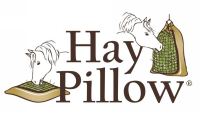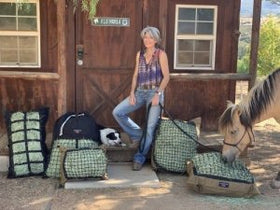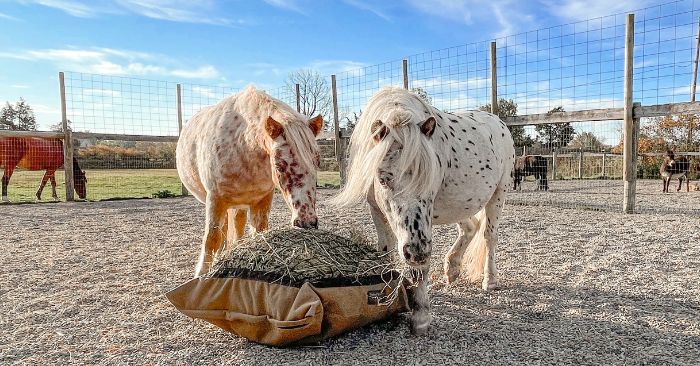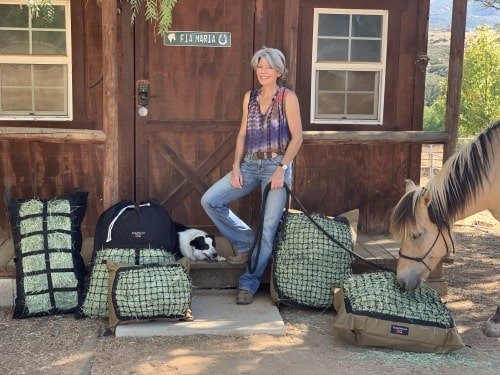Slow Feeding - Transition Tips & Techniques
Many of us make the switch to slow feeding with good intentions – whether it's to introduce the benefits of trickle feeding, minimize hay waste, or to manage weight. Whether your companions are new to slow feeding or you want to introduce smaller mesh sizes, we have tips and techniques to ease the transition.
The key to a successful transition to slow feeding or introducing a smaller mesh size is to make it a positive experience for your horse and avoid causing frustration, which defeats the purpose of happier, healthier horses.
Frustration elevates stress levels and increases gastric acid production. Signs of frustration include, but are not limited to:
- Persistent pawing
- Hostility towards the slow feeder
- Incessant shaking
- Refusing to eat
Two important factors within your control that influence your horse's frustration level are:
- How you introduce slow feeding.
- Your choice of mesh size.
If slow feeding is introduced thoughtfully, the vast majority of individuals adapt quickly, typically the first day!
Introducing Horses New to Slow Feeders
Most horses that are new to slow feeding are fed meals, usually two to three times a day. Meal-fed horses are typically anxious when fed and tend to be less patient with slow feeders and easily frustrated. Similarly, if you currently offer loose free choice hay and your goal is to minimize waste (6% or less), it’s important to gradually introduce slow feeders.
To ease the transition to slow feeding, provide your horse or herd with its current method and amount of hay - in addition to the slow feeder. Observe them to make sure they are adept at extracting hay from the new slow feed addition. You want to gradually reduce the original method and increase the amount of hay in the slow feeder until your horse is happily eating from the slow feeder without frustration.
Recommended Mesh Sizes:
- For horses, ponies, donkeys, mules or their barnyard buddies - we recommend the 1 ¾” mesh size as an introductory mesh size.
- For miniatures - we recommend the 1 ¼” mesh as a good introductory choice.
A Note on Mesh Size: Although your horse may eventually have the patience and ability to extract hay from a smaller mesh size, our goal is to create a positive association to slow feeding. Once a negative connotation is established, it may persist despite making adjustments.
We don't recommend introducing the next mesh size smaller unless the individual exhibits no signs of frustration.
Tips for Introducing a New Slow Feeder
- Don't overfill. If it's filled too tightly, it will force your equine to scrape their teeth across the netting to extract hay and cause frustration.
- Do pull hay through the openings. This gives your horse an easy start.
- Do place loose hay on top if using a Bale Net, Standard, Mini or Manger Hay Pillow.
- Do choose a slow feed solution appropriate for your horse's unique environment and weather conditions.
- Do monitor your horse and adjust accordingly.
Meal Fed Tip: If your horse is fed meals, allocate the amount of hay over a 24-hour period. For example, if you feed 24 pounds of hay a day (24 hours) = 1 pound per hour. Say you feed breakfast at 8:00 AM, lunch at 1:00 PM and dinner at 6:00 PM. Breakfast should be 5 pounds, lunch 5 pounds and dinner 14 pounds.
For Horses Ready to Move to Smaller Mesh Sizes
When your horse is happily eating from its slow feeder and you want to explore further reducing his rate of consumption, we recommend you choose the next mesh size smaller. Skipping to a smaller - or smallest – size too soon can backfire for you and your horse.
Any reduction in mesh size should be gradual - one mesh size at a time. Some horses may adjust to the smaller size with ease, some may adjust in time and others may not. Smaller mesh sizes do not necessarily equate to your equine eating slower - he may not be able to eat at all or become frustrated.
Individuals can vary significantly in how adept they are at using their lips and teeth. An individual may have the ability to extract hay from a particular mesh size, but not the patience level. Each individual has a mental and/or physical frustration threshold. Patience level always trumps your horse's ability when it comes to extracting hay.
Transition Tip: Here's where using a combination of two mesh sizes can be a huge advantage! Initially, offer the usual amount of hay in their current larger mesh size feeder and additional hay in the new smaller mesh feeder. Once your horse eats hay from the larger mesh size, they may be more relaxed and patient eating from the smaller mesh feeder (in the same feeding period).
Over time, as your horse becomes adept at eating from the smaller mesh size, you can:
- Gradually decrease the amount of hay in the larger mesh feeder and transition exclusively to the next size smaller - OR -
- Continue using both mesh sizes.
When offering slow fed forage to two or more individuals in the same enclosure, choose a mesh size to accommodate the least adept or patient individual and supply a minimum of one slow feed hay bag or net per individual. Ideally, offer one extra feeder than horses. This allows an open feeding station for any horse that is pushed off its hay by another.
Introducing a New Herd Member to Slow Feeding
If your herd is currently using slow feeders; consider the patience level and ability of the newest herd member as in Kim's case.
"I've always loved hay pillows and used them daily until I got Sampson. He would paw and paw and paw them and eventually killed both the ones I had, so I kinda just gave up the idea of using them. Well, I called @haypillowinc (they've got WONDERFUL customer service!!) and talked through the issues I'd had with Sampson. Turns out the mesh was way too small for him and I was overfilling the bags so he was just super frustrated! Per their recommendation, I got the larger size bag and mesh size and voila! Happy ponies that can't vacuum up their hay but also aren't frustrated! I was soooo happy to see them both eating hay so peacefully this morning!" Kim, @panther_castle
Sampson and Aries content with their larger mesh size Standard Hay Pillows.
Tips to Help Slow the Rate of Consumption
- Slow Feed Straight Grass Hay - Straight grass hay is optimum for slow feeding. Avoid buying grass hay mixed with alfalfa or clover. Legumes tend to be highly palatable and are a more concentrated source of calories per pound. If grass hay has even a small percentage of legumes such as alfalfa or clover it typically results in the same rate of consumption as if it were 100%. We recommend buying grass hay and legumes in separate bales. If you are feeding limited legume amounts in addition to slow fed grass hay, feed it loose in a tub or trough.
- Don't Blend Grasses - If you currently feed two different grass hays and blend them, determine which one is the least palatable and feed it separately. Blending palatable and less palatable grass hay results in the same enthusiasm and rate of consumption – making it more difficult to slow your horse down.
- Use Palatability to Your Advantage - We recommend feeding a less palatable, tested low sugar/starch hay to naturally curb the rate of consumption, encourage self-regulation and reduce the calories per pound. Learn how a simple shift in your forage selection can 1) reduce or eliminate meal time stress and 2) give your horse more chew time and bulk (without the weight gain).
- For Donkey Guardians Providing Barley Straw - Due to its low palatability and coarseness, providing free choice barley straw can extend your donkey's chew time and minimize waste. 1 ¾” mesh size has proven to be a popular choice for donkey guardians.
Recap
Make the switch to slow feeding or a reduction in mesh size a positive experience for your horse and always monitor his reactions when you make small adjustments. When choosing a mesh size for your slow feed hay bags or nets, it is prudent to err on the side of caution. Small mesh sizes do not necessarily equate to your horse eating slower - he may not be able to extract hay and experience frustration.
Whether your goal is to extend meals, minimize waste or offer slow fed free choice forage, keeping frustration at bay will enable your horse or herd to reap the mental and physical benefits of trickle feeding.
Helpful Resources
- Beyond Low Sugar/Starch - Choosing Hay for Weight Management
- Can Horses Eat More Hay Without Weight Gain? The Surprising Factors
- Are You a Prisoner of Feeding? Here's How I Broke Free
- How & Where to Test Your Horse's Hay & Interpret Results
- How to Introduce & Incorporate Free-Choice Forage: An Action Plan
- 9 Benefits of Slow Feeding Horses - Get Slow Feed Savvy
- Sand Colic - The Surprising (Simple) Cure & Prevention
- Equine Gastric Acid - 12 Facts You May Not Know
- Equine Gut Health - The Need for Feed
- Why Horses Need Salt & Why Salt Blocks Are Not Enough
- A Safer Always Have Hay Source – Mature Grass Hay
- Sugar Content of Pasture & Hay: Q & A with Katy Watts, Founder of Safergrass.org






